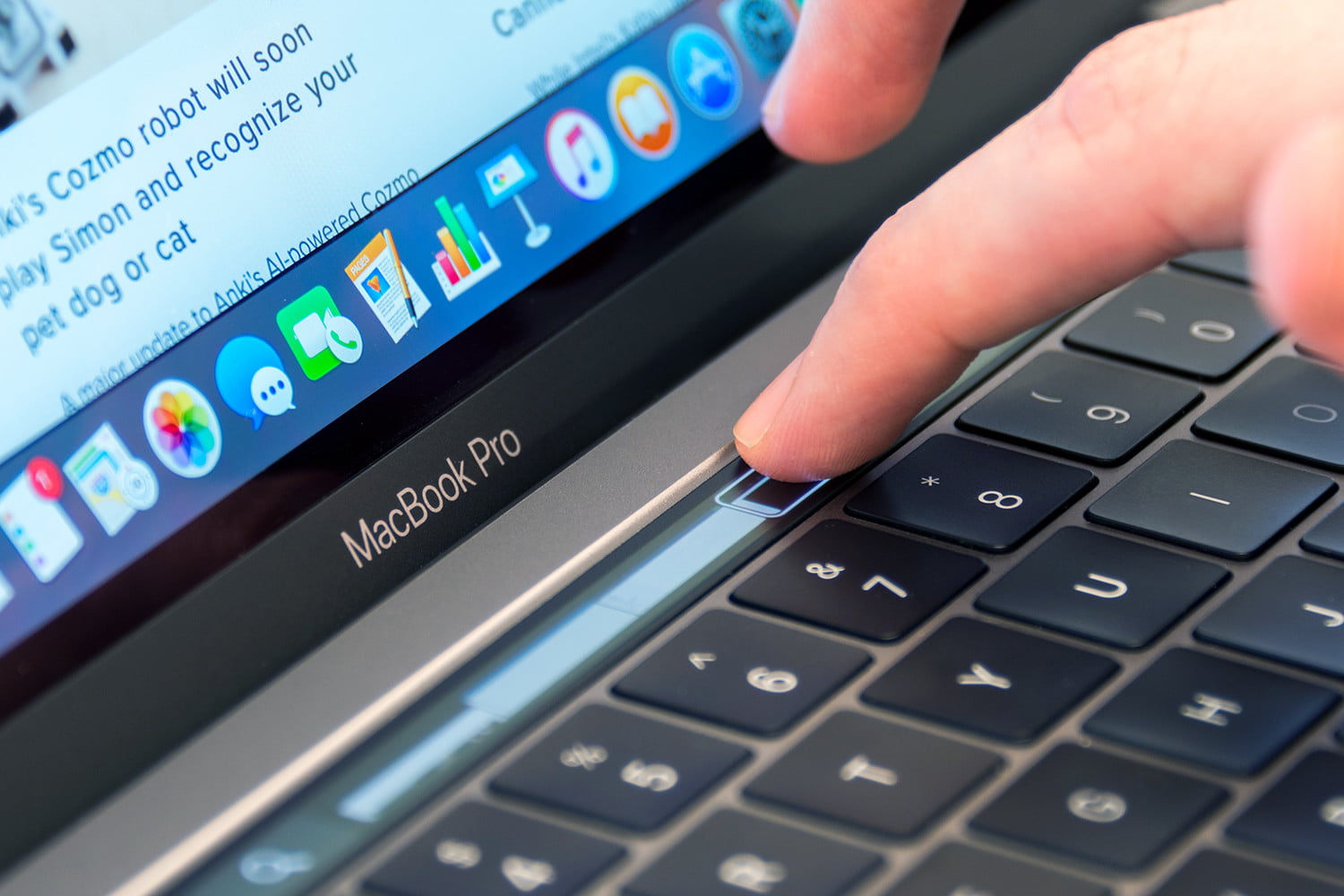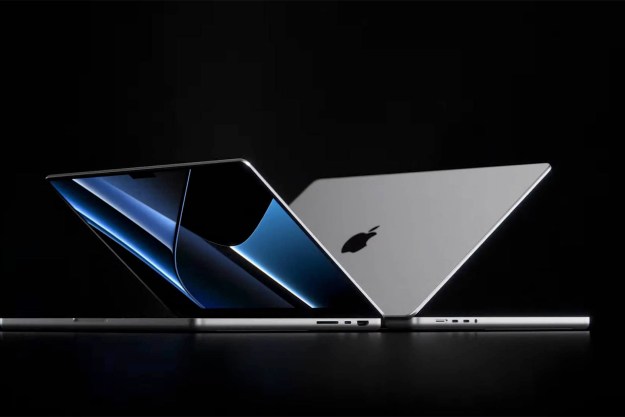If you’re in the market for a laptop, chances are you’re already overwhelmed by all the choices at your fingertips. There are just too many to count, which is why shoppers may default to first-party products from Apple, Microsoft, and Google. Their selections are few in number and are typically high-quality, long-lasting products.
In this fighting match to win your hard-earned dollars, we pitted Microsoft’s older Surface Laptop 2 against the newer 13-inch MacBook Pro. Will it be a fair fight? Probably not on the pricing front, since the Surface Laptop 2 is an older product. But in regards to design, performance, and portability, we make our arguments so you can decide which one is right for you.
Design

Both the MacBook Pro and the Surface Laptop 2 share similar attributes: A premium unibody aluminum build and a compact design. However, Microsoft and Apple each put their unique spins on the designs.
Microsoft chose an aluminum shell and a keyboard deck covered in Alcantara fabric, which adds warmth and texture to an otherwise cold metal design. It’s available in four colors including burgundy, platinum, cobalt blue, and black. The MacBook Pro is only available in two uninspired colors: Silver and Space Gray.
Both laptops stay true to their clamshell form factors — you won’t be able to move the screen into tablet and tent modes. However, their approach to touch input is vastly different. For example, the Surface Laptop 2 comes with a touchscreen that supports inking and pen input. The MacBook Pro doesn’t offer a touchscreen but instead includes a Touch Bar positioned just above the keyboard to quickly access shortcuts.
Both devices offer biometric security. Microsoft installed a Windows Hello infrared camera into the display for facial recognition. Apple currently installs a fingerprint Touch ID sensor on the power button located at the Touch Bar’s right end.
For typing, Microsoft’s keyboard is one of our favorites although we weren’t keen on the power button location, as we occasionally put it to sleep by accident. The drawback is that the keyboard deck is a dust and crumb magnet with plenty of spaces to collect ugly funk. Meanwhile, the MacBook Pro has one of the best keyboards we’ve used to date, now packing Apple’s magical scissor switches instead of the problematic butterfly switches it used for years.
Both models offer a precise touchpad that supports gestures.
Finally, the Surface Laptop 2 features Microsoft’s 13.5-inch PixelSense Display with a 2256 x 1506 resolution (201ppi) and touch input. The screen’s 3:2 aspect ratio may be more suited for productivity tasks, which require less scrolling. Meanwhile, Apple went wider on the MacBook Pro with its 13.3-inch Retina display, sporting a 2560 x 1600 resolution (227ppi) and a 16:9 aspect ratio.
Microsoft and Apple both quote contrast ratios within the 1,500:1 range, so you’ll get deep blacks. Apple claims that its Retina display also supports a wide color gamut, while the Surface Laptop 2 supports pen input.
Performance

The dividing line gets really strange here because Apple is slowly moving away from Intel. The current four starting points are split down the middle: Two lower-priced starting points with Apple’s new M1 chip, and two higher-priced starting points with 10th-generation Intel chips. The Surface Laptop 2, meanwhile, is based on older 8th-gen Intel U-series chips.
Comparing all five chips used in these two laptops seems a bit unfair, especially the two Intel sets, but here are some Geekbench single- and multi-core results to give you an idea of their base performance:
| Single | Multi | ||
| i5-8250U (4 cores) | 889 | 3146 | Surface Laptop 2 |
| i7-8650U (4 cores) | 957 | 3358 | Surface Laptop 2 |
| i5-1038NG7 (4 cores) | 1206 | 4224 | MacBook Pro |
| i7-1068NG7 (4 cores) | 1381 | 4948 | MacBook Pro |
| Apple M1 (8 cores) | 1727 | 7489 | MacBook Pro |
While Apple’s new M1 chip has the highest numbers on the chart, there’s a caveat: It’s far different from Intel’s CPUs. On a more technical level, the new chip is more in line with ARM-based designs you’ll find in mobile from Qualcomm, Samsung, and even Apple. That means it won’t natively run software developed for Intel-based machines. Instead, these programs must run through an emulator built into MacOS Big Sur.
So, while Apple’s eight-core chip, on paper, outperforms even the Intel-based CPUs in the other MacBook Pros, traditional software may or may not feel as snappy as it should. That will likely change as developers distribute versions of their programs that natively support the M1, but until then, performance could be an issue in terms of desktop software.
That said, you can configure the M1-based MacBook Pro with up to 16GB of RAM and up to 2TB of storage. The Intel configurations include the Core i5 or i7, up to 32GB of RAM, and up to 4TB of storage — you simply get more memory and storage with the Intel-based units. If you need more, the 16-inch model has options for a Core i9 CPU, 64GB of
Meanwhile, the Surface Laptop 2 ships with the Intel Core i5 or i7 CPU, up to 16GB of RAM, and up to 1TB of storage.
Neither the Surface Laptop 2 nor the 13-inch MacBook Pro has an option for discrete graphics. If that’s an issue, you could opt to attach an external graphics card, or bite the bullet and get the 16-inch MacBook Pro. It’s configurable with AMD’s Radeon Pro 5300M, Pro 5500M, and Pro 5600M discrete GPUs. The Surface Laptop 2 does not support external graphics.
On connectivity, Apple completely embraces the future by limiting the MacBook Pro to USB-C ports with Thunderbolt 3 and USB 4 — two with the M1 chip four with Intel. That means you’ll need a dongle for every external device that doesn’t have a USB-C connector. The Surface Laptop 2 has a few more options, supplying a USB-A port, a Mini DisplayPort jack, and the Surface Connect port — there is no USB-C. Both laptops include a 3.5mm headphone jack.
Lastly, the Surface Laptop 2 uses a magnetic charging cable, which can quickly unlatch in the event you trip over the cord. Ironically, this works like Apple’s MagSafe connector, which the company no longer uses.
Portability

The Surface Laptop 2 is slightly slimmer than the MacBook Pro in height, measuring 0.57 inches thick versus 0.61 inches on the MacBook Pro, although you won’t be able to really tell the difference. On the flip side, the Surface Laptop 2 is wider and deeper while staying lighter at 2.67 or 2.81 pounds, depending on the processor. The MacBook Pro weighs 3.1 pounds.
While the two are mostly similar in terms of weight and portability, the battery life is really where the MacBook Pro outshines the Surface Laptop 2. In our testing of the M1-based MacBook Pro, the battery lasted 16 hours in our web browsing tests and a hefty 21 hours in our video loop test. This circles back to the processor’s ARM-based roots, a design mobile chip makers use because it targets high performance while sipping on the battery, perfect for mobile devices.
Compared to the MacBook Pro, the Surface Laptop 2 can’t compete. In our tests, it lasted 8.5 hours in our web browsing test and over 11 hours in our video loop test. Out review of the Intel-based MacBook Pro didn’t provide specific numbers, but we saw between six and seven hours of general use on a single charge.
Windows or Mac? It’s in the ecosystem

While comparing specifications may be fun, the numbers game doesn’t paint an accurate picture of which laptop is more deserving of your money. You should buy a laptop that will tie into your workflow. If you’re locked into Apple’s ecosystem, going with a MacBook Pro may be a no-brainer.
The problem is, the Surface Laptop 2 is an older laptop, now replaced by the Surface Laptop 3. Microsoft only sells the latest generation, so you must get the older model through Amazon and other third-party sellers. For instance, you can still get a model from Amazon configured with the Core i5, 8GB of RAM, and 128GB of storage for $830. That’s significantly cheaper than the MacBook Pro’s $1,299 starting price, but you’re buying old hardware.
There’s no question that the latest MacBook Pro has a better base performance than the Surface Laptop 2. The big conundrum for long-time Apple customers would be sticking with Intel for now or jumping onto the M1 bandwagon and tolerating possible desktop software performance issues until all developers are on board with the new chip.
If you already own a MacBook, chances are you have no intention to jump the Apple ship unless you want a PC gaming machine. However, if you’re a long-time Windows user, getting the Surface Laptop 2 may be a cheap upgrade, but there could be better options on the market. If you’re wanting to ditch Windows altogether, the M1-based MacBook Pro is the perfect introduction to MacOS.
Editors' Recommendations
- Best Apple deals: Save on AirPods, Apple Watch, iPad, MacBook
- Surface Pro 10: all the major changes rumored for the new model
- The XPS 16 is fighting an uphill battle against the MacBook Pro
- Best 14-inch laptops for 2024: tested and reviewed
- The 5 best MacBooks for video editing in 2024


